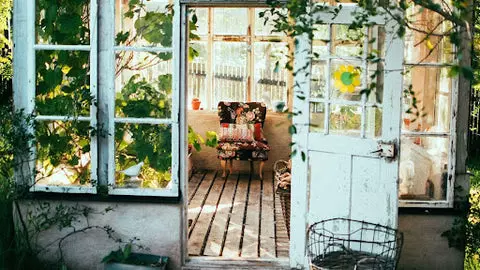 Photo by Sanaulac on Unsplash
Photo by Sanaulac on Unsplash
Creating the perfect garden is not just about beautiful plants and a picturesque patio. It's about finding balance and harmony in your outdoor space. That's where Feng Shui Garden comes in. It offers a way to capture the natural rhythms of the environment, promoting positive energy flow and creating a peaceful surrounding. Whether you have a sprawling lawn or a small balcony, understanding the basics of Garden Feng Shui can help you design a space that is not only visually appealing but also spiritually uplifting.
Understanding the Five Elements in Feng Shui
The first step in Garden Feng Shui is understanding the five elements: Wood, Fire, Earth, Metal, and Water. These elements work together to create a balanced outdoor space.
- Wood: Represents growth. Consider adding wooden benches or planting tall trees to incorporate the Wood element into your garden.
- Fire: Brings energy. A small, safe fire pit can be a great addition to introduce the Fire element into your garden.
- Earth: Stands for stability. Use large rocks or create a stone pathway to incorporate the Earth element into your garden.
- Metal: Encourages clarity. Consider adding metal garden sculptures or decorations to introduce the Metal element into your garden.
- Water: Calms and cleanses. A pond or fountain can be the perfect way to incorporate the Water element into your garden.
The Bagua Map - Location and Direction Matters
The Bagua Map is a tool used to analyze the energy of a space. Picture your garden divided into nine equal sections, each corresponding to an aspect of life such as wealth, health, or relationships. Placing the right elements in each section can foster positive energy in that aspect of your life.
- Water: Place water features like fountains in the garden's north, east, or southeast corners. The north is associated with your career and life path, the east with health and family, and the southeast with abundance and prosperity.
- Fire: Position the firepit in your garden's south, southwest, or northeast areas. The south represents fame, reputation, and recognition, the southwest signifies relationships, and the northeast represents self-love and spirituality.
- Metal: Metal elements are best placed in the West, Northwest, and North areas of your backyard. The West signifies completion and creativity, the Northwest represents the future and completion, and the North is associated with your career.
- Wood: Wooden elements should be placed in the east or southeast parts of your garden. You can also consider placing them in the south. However, avoid placing wooden elements in the northeast and southwest areas as it is considered bad luck.
- Earth: Elements like stones and rocks should be installed in the directions of Southwest, West, Northwest, and Northeast. Southwest represents romance and relationships, West is known for completion and creativity, Northwest represents Helpful People in our lives and travel, and the Northeast signifies Knowledge and Spirituality.
Balancing Yin and Yang
Finding the right balance between Yin (soft and feminine) and Yang (hard and masculine) is essential in Feng Shui. A garden that is too dark can feel gloomy, while an all-bright garden can be overwhelming. To achieve balance, mix different elements. Use soft lighting for a bit of Yin and bright flowers for a dash of Yang.
Incorporating Curved Features
One of the core principles of Feng Shui is the idea of fluidity and natural flow. In nature, straight lines and perfect right angles are rare. This concept extends to the Feng Shui way of designing a garden. Here are some ways you can incorporate curved features into your garden:
- Winding Paths: A curving path adds interest to your garden. It creates a sense of mystery and discovery, as you can't see everything at once.
- Rounded Water Features: A pond or fountain with rounded edges becomes a visual focal point in your garden. It adds balance and catches the eye.
- Circular Plant Beds: Round beds break up the monotony of a structured garden. They add creativity and make your garden design stand out.
Best Plants to Enhance Good Vibes
According to Feng Shui principles, the East, Southeast, and South areas of your garden are ideal for planting. Look for plants with soft, rounded leaves to emanate relaxation and calming energy. Heart-shaped leaves bring harmony to your garden. Don't overlook blooming shrubs; they add both color and positive vibes to your garden. Here are some Feng Shui plants for positive energy:
- Money Tree (Pachira Aquatica)
- Jade Plant or Money Plant (Crassula Ovata)
- Pothos
- White Bird of Paradise (Strelitzia Nicolai)
- Philodendron Heart Leaf (Philodendron Scandens)
- String of Hearts or Hearts on a String (Ceropegia Woodii)
- Peace Lily
- Rubber Plant (Ficus Elastica)
Key Takeaways
Garden Feng Shui is all about creating a balanced environment that fosters positive energy and well-being. To summarize, remember these key points:
- Understand the importance of incorporating wood, fire, earth, metal, and water to craft a harmonious outdoor area.
- Use the Bagua map to determine where to place different elements in your garden for the best energy flow.
- Mix light and dark, soft and hard features for a balanced and inviting garden.
- Add winding paths and rounded water features for a more natural and flowing garden layout.
Now that you have the knowledge, go ahead and create a garden that not only looks stunning but also brings you peace and positive energy. Happy gardening!

















